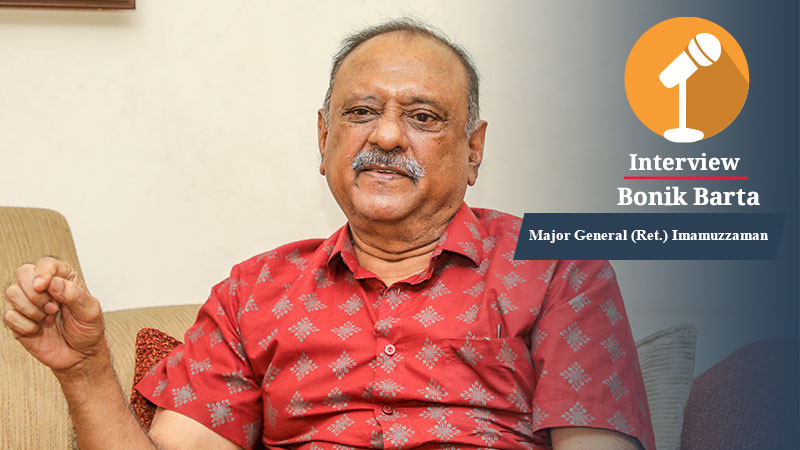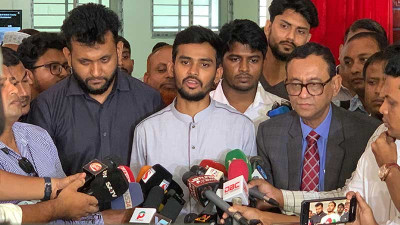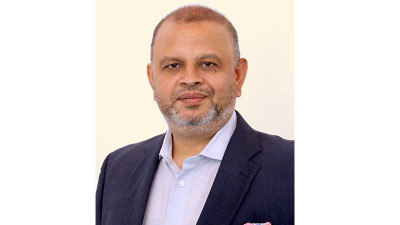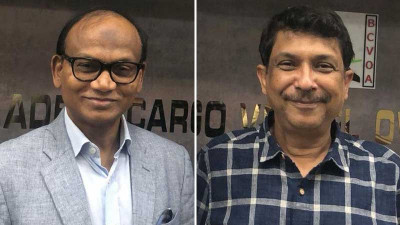 Photo: Bonik Barta
Photo: Bonik Barta Major
General (Ret.) Imamuzzaman Bir Bikram served as the Director General (DG) of
the Directorate General of Forces Intelligence (DGFI) from April 1995 to
February 1996. Later, he was appointed as the commander of the 9th Infantry
Division tasked with protecting Dhaka. During his tenure, in May 1996, he
thwarted a coup attempt by then-army chief Lieutenant General (Ret.) Abu Saleh
Mohammad Nasim. He was also a key witness in the 2004 ten-truck arms case,
which gained significant attention during the tenure of Sheikh Hasina’s
government. He spoke to Bonik Barta about the role of law
enforcement during Hasina’s administration and the BDR mutiny. The interview
was conducted by Anika Mahjabin.
Recently, Moeen U Ahmed made a
statement. How would you evaluate Moeen U Ahmed’s performance as army
chief?
Moeen
U Ahmed’s role during the BDR mutiny was not appropriate. At that time, he
followed a submissive policy. He should have taken a firmer stance. He was
overly dependent on the then-Prime Minister, carrying out her directives. The
entire army was behind him during that period, so he had a responsibility to
act. However, what he did was extremely immature.
The
failure also extended to the DG of BDR. Even though he had prior knowledge the
day before, he took no action. He had said, “Let the event end, and then we
will look into it.” But the incident unfolded during the event itself. The
intelligence agencies should have been monitoring the situation in advance. The
rebels were planning, printing leaflets, yet the agencies were not very active.
They were more focused on the Prime Minister’s arrival at the ceremony.
Why did the military become
controversial under Sheikh Hasina’s rule?
Since
Sheikh Hasina’s government came to power, the military has been given various
benefits. Loans were provided for purchasing cars. Salaries were increased.
During our time, salaries were around BDT 20,000-25,000, but during their time,
it increased to over BDT 100,000, including all allowances. This started after
2009. Officers were sent abroad for training, and promotions were given to
their chosen personnel. By providing such benefits, they essentially bought off
many officers.
The
military was also handed various businesses to run. Many commercial ventures
are now operated by the military. This has depoliticized them and diverted them
from their primary objective.
The
military’s main role is to protect the country from external enemies and
respond in emergencies. However, he had no strategy regarding neighboring
countries. Sheikh Hasina reversed the notion that India could be our primary
adversary and turned India into a friend, ensuring that we wouldn’t need to
engage in conflict with them, even in times of need.
Additionally,
many officers who did not comply faced numerous cases, fines, and were removed
from the military. Some were even placed in the infamous ‘Ainaghar’ (torture
cell), sending a clear message: “If you oppose us, you will face the same
consequences.”
As
a result, everyone became fearful. After the BDR mutiny, many who spoke out
during the post-event meetings were dismissed from their jobs.
Did law enforcement play any role
in Sheikh Hasina’s extended rule of a decade and a half?
A
major reason for this was the actions taken by the military during various
elections. Throughout Sheikh Hasina’s tenure, the military has maintained a
silent role. During the 2014 elections, the government might not have been able
to proceed without some support from then-army chief Iqbal Karim Bhuiyan. If
Bhuiyan had stepped down, a caretaker government would have been required. However,
his departure could have created the possibility for someone else to take his
place. Even within the military ranks, there were discussions that if he left,
there could be a change. However, they too were overly enthusiastic in
supporting the government. They were
loyal to the government. All army chiefs have played similar roles.
Law
enforcement was fully loyal to the Awami League. They worked in favor of the
party, especially the police force, which severely oppressed the opposition
party.
You served as the DG of DGFI before
the 1996 elections, overseeing the June election. How do you evaluate the roles
of those heading DGFI during the 2014, 2018, and 2024 elections?
The
intelligence agencies were blindly loyal to Sheikh Hasina. Their unwavering
allegiance stemmed from the desire to secure promotions and preserve their
jobs. They believed that their role was to ensure Sheikh Hasina’s victory in
every election, which, in turn, would increase their benefits.
During
my time at DGFI, despite Sheikh Hasina being in the opposition, we supported
her demands. When we saw that the Awami League was desperate for a caretaker
government, we convinced Khaleda Zia to agree, which led to the election and
restored peace in the country.
Was every agency submissive to
Sheikh Hasina’s government?
Yes,
every agency was submissive. Sheikh Hasina was in power for 15 consecutive
years, and the officials believed that she would remain in power indefinitely.
As a result, they continued to support her, backing her in every decision,
whether right or wrong.
How did the military’s attitude
toward India shift to a friendly one?
A
country’s military generally maintains a cautious stance toward its neighbors,
even if it isn’t openly hostile. In the past, Bangladesh held a neutral
position toward India, neither considering them a friend nor an enemy. There
was always some level of preparedness in case a conflict arose.
This
mindset existed during the presidencies of Ziaur Rahman and Hussain Muhammad
Ershad. However, under Sheikh Hasina, this approach changed. After 2009, the
military was steered away from viewing India as a potential adversary. Joint
military exercises with India began, though this didn’t have a significant
impact on us.
You served as DGFI’s director from
April 1995 to February 1996. Can you share your views on Aynaghar?
During
my tenure, there was no such thing as Aynaghar. We had a ‘Joint Interrogation
Cell’ where terrorists and spies were questioned. Occasionally, detainees were
brought in for a month or two, and we applied only the necessary pressure to
extract information. However, we never resorted to torture. Fear tactics were
used, but once information was obtained, the detainees were released. It wasn’t
open year-round. In my tenure as DG, no one was brought there. I
had to leave DGFI after eleven months. I was removed from DGFI because I wasn’t
overly enthusiastic about taking extreme measures.
After
Sheikh Hasina came to power, Aynaghar was established as a full-fledged torture
cell. One thing to note is that lower-level officers often take more extreme
measures than the government dictates, overzealously inflicting torture.
Brigadier Azmi, for example, was detained for espionage. As he was the son of
Ghulam Azam, he was taken to Aynaghar as a form of punishment.
How did Sheikh Hasina’s government
suppress the Hefazat movement in Shapla Chattar in May 2013?
The
government used the police to suppress the movement. Police opened fire,
resulting in many deaths, which allowed them to clear Shapla Chattar. The
police acted with excessive zeal, inflicting the most violence on the
protesters. The Border Guard Bangladesh (BGB), Rapid Action Battalion (RAB),
and the army did not engage to the same extent.
Why were you removed from DGFI
within less than a year?
Before
the political transition in 1996, the BNP government wanted to assign someone
strong to the 9th Infantry Division. As a result, I was transferred from DGFI
to the 9th Infantry Division in February 1996. At that time, General Nasim, the
army chief, attempted a coup. Khaleda Zia may have anticipated some unrest
within the military. We handled the situation effectively, and during the June
1996 election, we remained entirely neutral, which led to Sheikh Hasina’s
victory. If BNP personnel had been biased, the Awami League wouldn’t have won.
Can you explain the BDR mutiny?
The
BDR mutiny was not an isolated event. After Bangladesh’s independence in 1972,
Bangabandhu Sheikh Mujibur Rahman said that the BDR soldiers who had come from
the Mukti Bahini would not form the BDR. He believed there was no need for
border guards, as Bangladesh and India were friendly nations. Instead, he
proposed forming a national militia. However, the BDR soldiers did not accept
this and staged a mutiny in January 1972, firing shots in the air. Although no
casualties occurred, it was a sign of unrest. At that time, Major General C.R.
Dutta was brought in to calm the situation, and he announced that the BDR would
remain intact. The soldiers’ second demand was that the BDR should have its own
officers, meaning army officers should not be deputed to the BDR. However, C.R.
Dutta convinced Bangabandhu that without army officers, the BDR would not
become strong. Thus, army officers were brought into the BDR. This created
discontent.
In
1990, a year before Ershad’s fall, another rebellion occurred. Again, there
were no casualties, but the demand remained the same: they didn’t want army
officers in the BDR. This demand was not fulfilled, and dissatisfaction
simmered within the BDR for years.
After
the Awami League came to power in 2009, some BDR soldiers began engaging with
Awami League leaders, expressing their long-standing demands, including having
their own officers. Rumor has it that Sheikh Fazle Noor Taposh, State Minister
Jahangir Kabir Nanok, and ruling party leader Mirza Azam communicated with BDR
soldiers. The soldiers reportedly told them they were planning something, and
it seems the leaders gave their tacit approval. On February 25-26, 2009, the
mutiny took place. It can be said that two or three Awami League MPs knew about
the plan. They might have sanctioned the uprising, but no one foresaw its
severity, where 57 army officers would be killed.
The
mutiny was primarily carried out by the soldiers, with little external
instigation. On February 25, they killed the DG and other officers. By February
26, the uprising had subsided. Sheikh Hasina met with BDR representatives and
assured them that their demands would be addressed. The army took control after
February 26 and quelled the rebellion.
Why did the mutiny escalate to the
point where 57 officers and 74 people in total were killed despite politicians
being aware of it?
There
may have been external forces encouraging it. There could have been a
conspiracy involved.
What led to such an event within
two months of a new government being sworn in?
It
was an intelligence failure. The agencies neither anticipated nor predicted the
mutiny. They were focused on the prime minister’s visit to inaugurate BDR Week
and failed to notice the soldiers’ planning in the background.
Did the Prime Minister sense that
such an event could occur?
The
day before the mutiny, Prime Minister Sheikh Hasina was scheduled to attend a
BDR event on February 24 but did not. This alone suggests that she had some
premonition of the unrest.
Why do you think Prime Minister
Sheikh Hasina refrained from giving the army any orders after the rebellion
began on February 25?
She
probably wanted to avoid bloodshed. A clash between the two forces would have
resulted in more casualties. She may be hoped to resolve the situation through
negotiation and mutual understanding, which is why she called the mutineers for
talks.
Why do you think the government
treated the situation so lightly?
It’s
hard to say that the government entirely supported the mutiny, but some members
were aware of it. In reality, the BDR soldiers revolted against their officers.
There was no intermediary; it was the soldiers who carried out the mutiny.
That’s how I see it.
Many
people claim that the Awami League planned the event. However, no Awami League
members in Mujib coats came in and killed anyone. It’s fair to say that a few
members of the Awami League gave their silent approval. They essentially said,
“If you can do it, go ahead. We’ll see.” That’s how it could be interpreted.
Perhaps Sheikh Fazle Noor Taposh and others gave such a message.
Some argue that the goal was to
weaken the military. What do you think?
That
is an exaggeration. I don’t believe that. If the intention had been to weaken
the military, there would have been killings within the military as well. Why
target only the BDR? Even though the BDR officers were army officers, they were
working in the BDR at the time. So, it can be said that the intention was to
weaken the BDR. There may have been encouragement from a neighboring country,
but there was no direct involvement.
Recently, India’s Defense Minister
Rajnath Singh instructed their military to increase surveillance over
Bangladesh. How do you view this?
They
are likely concerned that extremists from Bangladesh could cross the border
into India, which could fuel unrest in India. However, India does not have the
capability or the courage to invade and take over Bangladesh. They may be
considering whether they can reinstate Sheikh Hasina by supporting her again.
But I don’t think Indian forces could hold their ground in Bangladesh. It’s
essentially just an attempt to scare us.
What impact would Sheikh Hasina’s
exile in India have on Bangladesh politics?
There
would certainly be some effect. If she had gone to another country, it wouldn’t
be as significant. Every country views her as a burden, and no one is willing
to take her in.
There was no military coup during
or after the popular uprising of 2024, even though coups typically occur during
power vacuums. Why do you think this time was different?
Under
the Awami League’s rule, it was always emphasized that no government should be
changed through unconstitutional means. Over the past 15 years, the army has
been trained with that ideology in mind. Due to this, they didn’t have the
courage to seize power. They were mentally conditioned to avoid undemocratic
power transfers. In the 1970s and 1980s, such thinking existed, but it has
since dissipated.
Additionally,
the current army chief, Waker-uz-Zaman, is a neutral individual. If he had been
overly ambitious, he might have tried to take power, but he likely realized
that not everyone would support him if he acted alone, making it too risky.
Furthermore, the constitution clearly states that the army cannot take power by
legal means.
Can you tell us about the
‘Ten-Truck Arms’ case?
During
Pakistan’s rule, the Pakistani government used the territory of East Pakistan
to supply arms to Northeast India. That stopped in 1975. Intelligence agencies
had always kept the Chattogram-Sylhet route open for arms smuggling. However,
after the Awami League came to power, it was completely shut down. The claim
that Bangladesh was used to supply weapons to Northeast India is not true. But
under the BNP regime, this route was used, and the incident was exposed,
leading to widespread awareness. Later, when Moeen U Ahmed visited India, the
Indian government asked him to investigate the matter again. Upon further
investigation, it was found that the arms were intended for Assam’s ULFA group.
Legal proceedings were carried out, and the case was resolved with punishments.
Although the BNP had previously conducted an investigation, it was dismissed
under Indian pressure, and a new investigation began. The Awami League
completed the investigation when they came to power in 2009.
Was the BNP government involved in
the arms smuggling at the time?
I’m
not sure if the top levels of the government knew, but intelligence agencies
were certainly overzealous. As I’ve mentioned, many things were unknown to the
Prime Minister and ministers, but mid-level government officials acted eagerly
on their own.
You were the chairman of the
Bangladesh Chemical Industries Corporation (BCIC) at the time of the ‘Ten-Truck
Arms’ case. Soon after, you retired from your position. Did the case influence
your decision to retire?
There’s
no connection between my retirement and the case. At that time, I was the
chairman of BCIC, which is why I had to testify. The arms were unloaded in
front of a BCIC factory, Urea Fertilizer Limited. So as an eyewitness, I
provided testimony. The then-secretary of the Ministry of Industry was also a
witness.






